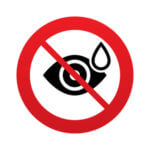Posted by: Laurel Eye Clinic in News

Experiencing blurry vision, halos around lights, or glare at night? These are classic symptoms of cataracts! If you have a cataract that’s affecting your vision, the only solution is cataract surgery.
When many people think of cataract surgery, the first thing that comes to mind is the drops. There are so many!
You need drops before the procedure and then drops after to reduce inflammation. But what if there was another option? Keep reading to learn about dropless cataract surgery!
Why do I need cataract surgery?
There’s nothing worse than seeing the world in a fog. What was once clear and vibrant is now dull and faded. That’s what living life with cataracts is like!
This is where cataract surgery comes in. Cataract surgery is the only way to treat cataracts. Yes, you can wear glasses or contacts to correct your vision, but they’ll stop working if you have cataracts.
Cataracts form because proteins in the lens start clumping together. This is a gradual process, meaning that a cataract could take years or decades before it’s finished forming!
You may not notice a cataract when it first begins developing. This could even occur as early as your forties or fifties! Cataracts aren’t something you need to worry about until they affect your vision.
At this point, a cataract makes enjoying everyday activities impossible. These can include things like sewing, walking, cooking, fishing and so much more.
When you have a cataract that needs removal, it can be like looking through a foggy window. No matter how hard you try, there’s no way to see through the fog.
This is a sure sign that you need to start considering cataract surgery! If you choose not to have cataract surgery, your vision will only continue to get worse. With cataract surgery, this is completely preventable!
 What is dropless cataract surgery?
What is dropless cataract surgery?
Let’s start at the beginning. Dropless cataract surgery is cataract surgery, except without drops.
During dropless cataract surgery, the natural lens of the eye is removed through a small incision. Once the cataract has been removed, the lens is replaced with an artificial intraocular lens or IOL.
An IOL is a lens that’s implanted in your eye during cataract surgery. The IOL takes over the job that the lens was performing before it became cloudy. This is what allows you to have clear vision after cataract surgery!
Cataract surgery is one of the safest procedures you can undergo. Dropless cataract surgery is no exception! In fact, it’s just as safe as cataract surgery. The only difference is you don’t have to deal with drops afterward because the surgeon injects the necessary medications during surgery and this takes the place of eye drops.
In the injection is a combination of antibiotics and an anti-inflammatory agent. These medications are absorbed by the eye over the course of the next month.
That doesn’t sound like a big deal until you consider how many drops you put in your eyes to prepare for cataract surgery!
Putting in drops before dropless cataract surgery
Before dropless cataract surgery, on the day before your procedure, you’d use an antibiotic eye drop to prevent the chance of infection. You needed to use this eye drop 4 times a day! With dropless cataract surgery, you don’t have to worry about any of this!
 Why do I need to use drops after cataract surgery?
Why do I need to use drops after cataract surgery?
If you have traditional cataract surgery, you’ll need to follow an eye drop regimen before and after. You’ll be prescribed an antibiotic eye drop and anti-inflammatory eye drops.
These drops help prevent infection and inflammation. After any kind of surgery, you’re more vulnerable to infections and complications. Your eyes are no exception to this!
You’ll need to take all of these drops several times a day to get the full effect. This could take anywhere from one to six weeks. It all depends on how your eye is healing after cataract surgery and what your doctor recommends.
What they might not tell you before you undergo cataract surgery is how much you’re paying for the drops. The bottles aren’t exactly large, so you may need to refill them a few times while recovering.
Taking drops four times a day means you could be spending about $400 per eye! The cost of cataract surgery becomes even greater if you opt for a premium IOL. Now, this is where dropless cataract surgery starts becoming pretty attractive!
The advantages of dropless cataract surgery
What if we told you that dropless cataract surgery means potentially eliminating the need for drops with cataract surgery? It can! How is this possible?
During dropless cataract surgery, you don’t have to follow a drop regimen before or after. Instead, at the Laurel Eye Clinic, we administer medications during surgery at the time of surgery that contains the same antibiotics and anti-inflammatory agents found in the drops. Patients who undergo dropless cataract surgery get the same benefits without drops.
In most cases, patients are able to completely cut out following a drop regimen for cataract surgery! Dropless cataract surgery can save you time, money, and of course, gives you your sight back.
 Life after dropless cataract surgery
Life after dropless cataract surgery
Like any surgical procedure, you’ll spend some time recovering after dropless cataract surgery. You won’t be able to drive yourself home, so make sure you have someone with you to take you home.
You’ll want to take it easy once you’ve made it home after the procedure. This means avoiding any strenuous activities and rigorous exercising. But one thing you don’t have to worry about after dropless cataract surgery is an eye drop regimen!
Instead, you can spend more time focusing on your recovery and getting back to the things that you love. After dropless cataract surgery, your eyes will be more sensitive, so treat them with some TLC!
For the first day or so after your surgery, you may feel tired from the anesthesia. You may also feel unsteady as your vision recovers. Remember to take it easy and ask friends or family for help if you need it.
It’s important to not get lonely or depressed during your recovery period. Your vision will improve gradually as you continue recovering.
It’s normal if your vision fluctuates, seems blurry, or isn’t quite clear yet. This can take a few weeks as your eyes adjust to their new normal and your IOL.
Once you’ve recovered from dropless cataract surgery, get ready to see the world! Colors are more vibrant, and you may even have the best vision of your life! It’s a time to celebrate and say hello to the beautiful world all around you.
Wondering if dropless cataract surgery could be right for you or your loved one? Schedule an appointment at the Laurel Eye Clinic in Duncansville, PA today! Don’t let fear or anxiety stand in the way of your best life any longer.


 What is dropless cataract surgery?
What is dropless cataract surgery? Why do I need to use drops after cataract surgery?
Why do I need to use drops after cataract surgery? Life after dropless cataract surgery
Life after dropless cataract surgery